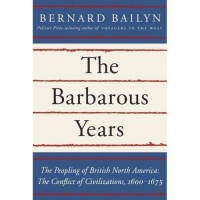Quick Lit Bits: "The Barbarous Years: The Peopling of British North America"
- Details
- Published on Friday, 22 February 2013 14:52
- Written by Kevin Kizer
Do you enjoy curling up with a book filled with stories of torture, slaughter and all kinds of nastiness? Well, my friend, "The Barbarous Years: The Peopling of British North America: The Conflict of Civilizations, 1600-1675" by Bernard Bailyn is the book for you! And since it’s about American History you can feel like a patriot as you are reading.
Now, there are many history books out there that cover America in the 1700s, but there aren’t that many covering the century beforehand when there weren’t really “American settlers” so much as some rag-tag groups of Brits, Finns, Dutch, et al, trying to find a new place to call home.
The popular myth we hear about American settlers is that they were escaping religious freedom. While that was true for some, the vast majority were over here to make a buck, or to make a buck for someone else. The ships were, after all, owned by businesses and those businesses needed to make money. In order to do that, they needed as many people as possible shipped to the new country and they took whomever they could throw on board – including criminals, homeless and orphaned children, along with religious clerics and college graduates.
When they first arrived they got on fairly well with the Native Americans, mingling and trading together. But then the Native Americans soon realized these new people were not just going to USE the land but were going to TAKE the land. That’s when all hell broke loose. While we have no evidence of what their battles were like, I'd like to think they were a lot like the battle reenactments of the Batley Townswomen's Guild.
From indiscriminate slaughter to stomach-turning torture, the settlers and Native Americans set to one-upping one another on the violence scale. It seemed to be the one thing at which both groups excelled. Example: one of the Native American specialties was dismembering a settler digit by digit – starting with individual finger and toe joints – until all that was left was a still-living stump of a human, which could live up to three days (if taken care of properly).Their chief weapons, like the Spanish Inquisition, were fear, surprise and ruthless efficiency.
There’s also an interesting story about settlers who decided to return to England after an overthrow of power there made the threat of religious persecution negligible. Around 12 percent of the settlers returned – including one-third of clerics and half of all college graduates. Many of those that stayed in
Obviously, there is a lot of brutality in this book but it’s also an enlightening look at an era that is quite often ignored or brushed over in most history texts.


















































